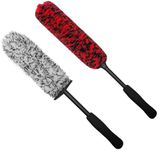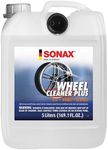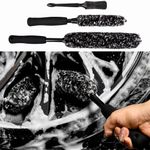Buying Guide for the Best Rim Cleaners
Choosing the right rim cleaner is important for keeping your car wheels looking their best and preventing long-term damage. Rim cleaners are specially formulated to remove brake dust, road grime, and other tough residues that regular soap and water can't handle. When picking a rim cleaner, it's important to consider the type of rims you have, how dirty they usually get, and how much effort you want to put into cleaning. Understanding the key features of rim cleaners will help you select a product that is safe, effective, and easy to use for your specific needs.Compatibility with Rim MaterialRims can be made from different materials such as aluminum, chrome, steel, or alloy, and some cleaners are designed for specific types. Using the wrong cleaner can damage the finish or even corrode the rim. Always check if the cleaner is safe for your rim material. If you have painted, polished, or coated rims, look for a cleaner labeled as safe for all finishes. If your rims are bare metal or chrome, make sure the cleaner is formulated for those surfaces. Knowing your rim type is the first step to picking a safe product.
Cleaning StrengthCleaning strength refers to how powerful the cleaner is at removing dirt, brake dust, and grime. Some cleaners are gentle and designed for light, regular cleaning, while others are heavy-duty for tough, baked-on residues. If you clean your rims often and they don’t get very dirty, a mild cleaner is usually enough. If you drive in harsh conditions or haven’t cleaned your rims in a while, a stronger formula may be necessary. Choose the strength based on how dirty your rims typically get and how often you plan to clean them.
pH LevelThe pH level of a rim cleaner tells you how acidic or alkaline it is. Acidic cleaners are very effective at removing stubborn brake dust but can be harsh on sensitive finishes. Neutral or pH-balanced cleaners are gentler and safer for all rim types, especially if you have delicate or custom finishes. If you’re unsure about your rim’s durability, or if you want to play it safe, go for a pH-neutral cleaner. If you need to tackle heavy buildup and your rims are tough, an acidic cleaner might be suitable, but always follow the instructions carefully.
Application MethodRim cleaners come in different forms such as sprays, gels, or foams. Sprays are quick and easy to apply, covering large areas fast. Gels tend to stick better to vertical surfaces, giving the cleaner more time to work on tough grime. Foams can help lift dirt away from the surface. If you want a fast and convenient clean, sprays are a good choice. If you need to tackle stubborn dirt or want more control, gels or foams might be better. Think about how much time and effort you want to spend when choosing the application method.
Residue and Rinse-abilitySome rim cleaners rinse off easily with water, leaving no residue, while others may require more scrubbing or leave a film behind. If you want a quick and hassle-free cleaning process, look for a cleaner that advertises easy rinsing and no residue. This is especially important if you don’t have access to a pressure washer or want to avoid extra wiping. If you don’t mind spending more time for a deeper clean, a product that needs a bit more effort might be acceptable.
Environmental and Safety ConsiderationsSome rim cleaners contain harsh chemicals that can be harmful to the environment or your skin. If you’re concerned about safety or eco-friendliness, look for biodegradable or non-toxic formulas. These are safer to use around pets, plants, and children, and are less likely to harm the environment. If you have allergies or sensitive skin, or if you often clean your rims at home, this is an important factor to consider.















